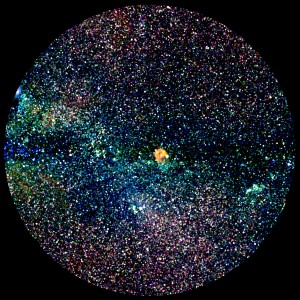Revolutionary image of the X-ray sky
1 Feb 2024
The data from the first eROSITA sky survey are now available, it is the largest catalogue of high-energy cosmic sources, with details of distant stars, black holes and our own galaxy
1 Feb 2024
The data from the first eROSITA sky survey are now available, it is the largest catalogue of high-energy cosmic sources, with details of distant stars, black holes and our own galaxy
The German eROSITA consortium now released the data for its share of the first all-sky survey by the soft X-ray imaging telescope flying aboard the Spectrum-RG (SRG) satellite. With about 900.000 distinct sources, the first eROSITA All-Sky Survey (eRASS1) catalogue has yielded the largest X-ray catalogue ever published. Along with the data, the consortium released today a series of scientific papers describing new results ranging from studies of the habitability of planets to the discovery of the largest cosmic structures.
Based on just the first six months of observations, eROSITA has already detected more sources than had previously been known in the 60-year history of X-ray astronomy. Now available to the worldwide science community, the data will revolutionise our knowledge of the Universe at high energies.
The eRASS1 observations with the eROSITA telescope were carried out from 12 December 2019 to 11 June 2020. In the most sensitive energy range of the eROSITA detectors (0.2-2 keV), the telescope detected 170 million X-ray photons, for which the cameras can accurately measure the incoming energy and arrival time. The catalogue was then constructed – after careful processing and calibration – by detecting concentrations of photons in the sky against a bright, large-scale, diffuse background. After eRASS1, eROSITA has continued scanning the sky and accumulated several additional all-sky surveys. Those data will also be released to the world in the coming years.
This catalog of X-ray sources is an important foundation for the development of Artificial Intelligence methods in astrophysics and cosmologyProf. Sven Krippendorf
The eRASS1 catalogue covers half the X-ray sky, the data share of the German eROSITA consortium. It consists of more than 900.000 sources, including some 710.000 supermassive black holes in distant galaxies (active galactic nuclei), 180 000 X-ray emitting stars in our own Milky Way, 12.000 clusters of galaxies, plus a small number of other exotic classes of sources like X-ray emitting binary stars, supernova remnants, pulsars, and other objects.
“These are mind-blowing numbers for X-ray astronomy,” says Andrea Merloni, eROSITA principal investigator and first author of the eROSITA catalogue paper. “We’ve detected more sources in 6 months than the big flagship missions XMM-Newton and Chandra have done in nearly 25 years of operation.”
Co-ordinated with the release, the German eROSITA Consortium has submitted almost 50 new scientific publications to peer-reviewed journals, adding to the more than 200 which had already been published by the team before the data release. “The scientific breadth and impact of the survey is quite overwhelming; it’s hard to put into a few words,” says Mara Salvato, who as spokesperson for the German eROSITA consortium co-ordinates the efforts of about 250 scientists organised into 12 working groups.
The scientific analysis of this dataset also involves cosmologists at LMU Munich, just a few kilometers south of MPE. “This catalog of X-ray sources is an important foundation for the development of Artificial Intelligence (AI) methods in astrophysics and cosmology.” says Sven Krippendorf, who develops AI methods at LMU to extract more information about the structure of our Universe from eROSITA data. “The contiguous sky coverage of the eROSITA cluster sample is truly spectacular, allowing the mapping of the large scale structure over the full extragalactic sky.”, says Daniel Hernández-Lang, who, as a doctoral student at LMU, contributed to the long-term optical imaging campaign DeROSITAS that was designed to complete the sky coverage needed to support the creation of the eROSITA cluster catalog. “This eRASS data release is a tremendous opportunity for the worldwide scientific community!”, says LMU Professor Joe Mohr, who served as senior scientist in eROSITA between 2009 and 2020 preparing for the creation and cosmological analysis of the galaxy cluster catalogs. “We heartily congratulate our colleagues in the eROSITA collaboration for a job well done!”

The picture shows point-shaped X-ray sources. | © MPE, J. Sanders für das eROSITA-Konsortium
This first eRASS data release (DR1) makes public not only the source catalogue, but images of the X-ray sky at multiple X-ray energies and even lists of the individual photons with their sky positions, energies and precise arrival times. The software needed to analyse the eROSITA data is also included in the release. For many source classes, supplementary data from other wavebands has also been incorporated into so-called “value-added” catalogues that go beyond pure X-ray information. “We’ve made a huge effort to release high-quality data and software,” added Miriam Ramos-Ceja, who leads the eROSITA Operations team. “We hope this will broaden the base of scientists worldwide working with high-energy data and help push the frontiers of X-ray astronomy.”
Scientists at the LMU also contribute to the physical interpretation of eRASS data, based on comparison to large scale, cosmological, hydrodynamical simulations. “It is astonishing to see eRASS data to detect for the first time an individual gas filament so far away from a galaxy cluster”, says LMU Professor Klaus Dolag. “Reproducing this observation of an individual system where both clusters are matched and the filament spine is reproduced as well helps us to better understand, how exactly these structures form”, says Benjamin Seidel, who, as a doctoral student at LMU, contributed to SLOW, a new simulation tailored to reproduce the main features of the Local Universe.
“The eROSITA collaboration has done an outstanding job with the data release and at the same time publishing all of these amazing new results,” says Kirpal Nandra, Director at MPE. “There’s a lot more to come from us.“